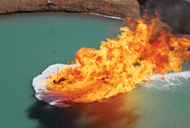- Number 285 |
- April 27, 2009
Largest-ever LNG fire test probes hazards from tanker spills

The largest-ever LNG fire test
on water was conducted at Sandia
in February. To perform the test
Sandia researchers built a lined,
two-meter-deep pond 120 meters
in diameter.
Scientists at DOE's Sandia National Laboratories are evaluating data from some 50 sets of instruments used in February in the largest-ever liquefied natural gas (LNG) fire test on water. The test was conducted in a remote location on Sandia’s grounds on Kirtland Air Force Base.
The test is the first of three scheduled this year that Sandia is performing for the Department of Energy’s Office of Fossil Energy. Congress directed DOE to conduct the LNG experiments, and DOE turned to Sandia to perform the tests because of Sandia’s experience and expertise in conducting large-scale fire tests.
LNG is natural gas that has been cooled to its liquid state at atmospheric pressure to facilitate transportation where pipelines are not available. Natural gas from overseas is often imported into the U.S. as LNG on large, specially designed double-hulled tankers, some carrying as much as 70 million gallons of LNG.
The Sandia tests are designed to determine the hazards from a potential fire if one of the LNG cargo tanks on an LNG carrier is breached and a spill occurs.
“This 20-meter-diameter LNG pool fire was the largest test of an LNG spill on water,” said Mike Hightower, Sandia’s LNG program manager and one of many Sandia researchers who have authored reports on risk-based studies of the hazards of LNG marine imports over the past several years. Smaller tests—around five to six meters in diameter—have been conducted by other organizations in the past, requiring scientists to extrapolate data from these smaller tests to estimate hazards from a possible 200- to 300-meter-diameter LNG pool fire.
Sandia researchers expect that data collected from the larger pool fires will provide better information on large-scale LNG burn rates on water, thereby improving LNG pool fire models and associated hazards distance predictions.Submitted by DOE's Sandia National Laboratories
